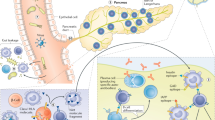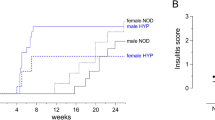Abstract
HUMAN type 1 (insulin-dependent) diabetes is a common autoimmune disease of the insulin-producing β cells of the pancreas which is caused by both genetic and environmental factors1,2. Several features of the genetics and immunopathology of diabetes in nonobese diabetic (NOD) mice are shared with the human disease1,3,4. Of the three diabetes-susceptibility genes, Idd-1 (refs 5–7), -3 and -4 (ref. 4) that have been mapped in mice to date, only in the case of Idd-1 is there any evidence for the identity of the gene product: allelic variation within the murine immune response /-A/3 gene and its human homologue HLA-DQB1 correlates with susceptibility, implying that I–Aβ is a component of Idd-1 (refs 5–11). We report here the mapping of Idd-5 to the proximal region of mouse chromosome 1. This region contains at least two candidate susceptibility genes, the interleukin-1 receptor gene (Il-lrl; ref. 12) and Lsh/Ity/Bcg (refs 13-19), which encodes resistance to bacterial and parasitic infections and affects the function of macrophages.
This is a preview of subscription content, access via your institution
Access options
Subscribe to this journal
Receive 51 print issues and online access
$199.00 per year
only $3.90 per issue
Buy this article
- Purchase on Springer Link
- Instant access to full article PDF
Prices may be subject to local taxes which are calculated during checkout
Similar content being viewed by others
References
Castano, L. & Eisenbarth, G. S. A. Rev. Immun. 8, 647–679 (1990).
Risch, N. Am. J. hum. Genet. 40, 1–14 (1987).
Makino, S. et al. Expl Anim. 29, 1–13 (1980).
Todd, J. A. et al. Nature 351, 542–547 (1991).
Hattori, M. et al. Science 231, 733–735 (1986).
Prochazka, M., Leiter, E. H., Serreze, D. V. & Coleman, D. L. Science 237, 286–289 (1987).
Wicker, L. S. et al. J. exp. Med. 165, 1639–1654 (1987).
Todd, J. A., Bell, J. I. & McDevitt, H. O. Nature 329, 599–604 (1987).
Miyazaki, T. et al. Nature 345, 722–724 (1990).
Slattery, R. M. et al. Nature 345, 724–726 (1990).
Lund, T. et al. Nature 345, 727–729 (1990).
Copeland, N. G. et al. Genomics 9, 44–50 (1991).
Blackwell, J. M. et al. Immun. Lett. (in the press).
Schurr, E. et al. Immun. Today 12, 42–45 (1991).
Skamene, E. et al. Nature 297, 506–509 (1982).
Malo, D. et al. Genomics 10, 356–364 (1991).
Mock, B. et al. Genomics 7, 57–64 (1990).
Hillyard, A. L., Doolittle, D. P., Davisson, M. T. & Roderick, T. H. Locus Map of the Mouse with Comparative Points of Human on Mouse (Jackson Laboratory, Barbor, Maine, 1991).
Hutchings, P. et al. Nature 348, 639–642 (1990).
Harada, M. & Makino, S. Diabetologia 27, 604–606 (1984).
Yasunami, R. & Bach, J.-F. Eur. J. Immun. 18, 481–484 (1988).
Wicker, L. S., DeLarato, N. H., Pressey, A. & Peterson, L. B. in Proc. P & S Biomed. Sci. Symp.; Molecular Mechanisms of Immunological Self-recognition (eds Vogel, H. J. & Alt, S. W.) (Academic, New York, in the press).
Wicker, L. S., DeLareto, N. H., Pressey, A. & Peterson, L. B. in Frontiers in Diabetes Research II: Lessons from Animal Diabetes III (ed. Shafrir, E.) 67–72 (Smith-Gordon, London, 1991).
Jacob, C. O., Aiso, S., Michie, S. & McDevitt, H. O. Proc. natn. Acad. Sci. U.S.A. 87, 968–972 (1990).
Mandrup-Poulsen, T. et al. Curr. Topics Microbial. Immun. 164, 169–193 (1990).
Sims, J. E. et al. Science 241, 585–589 (1988).
Love, J. M., Knight, A. M., McAleer, M. A. & Todd, J. A. Nucleic Acids Res. 18, 4123–4130 (1990).
Cornall, R. J., Aitman, T. J., Hearne, C. M. & Todd, J. A. Genomics 10, 874–881 (1991).
Hearne, C. M. et al. Mamm. Genome 1, 273–282 (1991).
Hogarth, P. M. et al. J. Immun. 146, 369–377 (1991).
Author information
Authors and Affiliations
Rights and permissions
About this article
Cite this article
Cornall, R., Prins, JB., Todd, J. et al. Type 1 diabetes in mice is linked to the interleukin-1 receptor and Lsh/lty/Bcg genes on chromosome 1. Nature 353, 262–265 (1991). https://doi.org/10.1038/353262a0
Received:
Accepted:
Issue Date:
DOI: https://doi.org/10.1038/353262a0
Comments
By submitting a comment you agree to abide by our Terms and Community Guidelines. If you find something abusive or that does not comply with our terms or guidelines please flag it as inappropriate.



